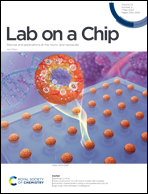High-DNA integrity sperm selection using rheotaxis and boundary following behavior in a microfluidic chip†
Abstract
Rheotaxis, as one of the main natural guidance mechanisms in vivo, has been used in microfluidics to separate motile sperm. However, the lack of DNA integrity assessment and the inability to separate the cells in a specific reservoir have been the main limitations for the practical application of most of the devices using rheotaxis for sperm separation. Here, we present a microfluidic chip that can separate highly motile sperm using their inherent rheotaxis and boundary-following behavior in a network of boomerang-shaped microchannels. The device design is informed by our FEM simulation results to predict sperm trajectories. Experimental results demonstrate the device's performance to separate over 16 000 motile sperm in under 20 min, sufficient for droplet-based IVF. Separated cells are classified into two motility groups, highly motile (swimming speed > 120 μm s−1) and motile (swimming speed < 120 μm s−1). The device selects sperm with over 45%, 20%, and 80% improvement in motility, the number of highly motile sperm, and DNA integrity, respectively, suggesting promising potential for applications in assisted reproduction.



 Please wait while we load your content...
Please wait while we load your content...